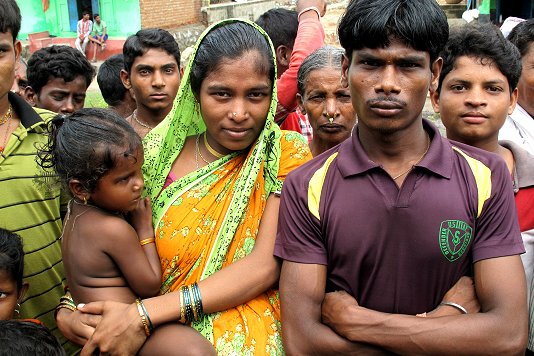
Disaster preparedness saves thousands of lives during Cyclone Phailin

18 October 2013
Despite the successful evacuation of 1 million people and minimal loss of life, Cyclone Phailin – the most powerful tropical storm to hit India’s east coast in 14 years – has still left significant needs in its wake.
In the village of Sunapur, the Indian Red Cross cyclone shelter has towered above every other structure since its construction in 1995. Last weekend, it once again became the temporary refuge for 500 villagers and their animals as Cycline Phailin made landfall on India’s east coast.
Kamala, eight-months pregnant with her second child, was one of those who rushed to the shelter on hearing about the approaching cyclone.
“I acted as soon as I heard the early warnings from the Red Cross volunteers,” she says. “That was the day before the cyclone was supposed to make landfall, but I went anyway. I didn’t want to risk anything.
“Then the cyclone and heavy rain hit the following night. I was scared, knowing I couldn’t move very fast.”
Dedicated network
The shelter saved hundreds of lives, but effective disaster preparedness requires more than strong buildings.
The safety of people in Sunapur lies in the hands of a dedicated network of Red Cross community volunteers that make up the Shelter Disaster Managing Committee.
This group is responsible for the early warning and maintaining the safety of those that come to the shelter.
The cyclone and the floods which followed have affected over 11 million people, with five districts in Odisha state left submerged.
More than 400,000 hectares of crops and 200,000 houses have been damaged or destroyed.
Thousands of people have no choice but to remain in shelters or take refuge in evacuation centres.
Dr S. P. Agarwal, Secretary General of the Indian Red Cross Society, said the preparedness efforts of the society and communities had saved thousands of people: “In the wake of the cyclone, people have been left destitute, and the needs for food, shelter, water and sanitation will remain high for a considerable period of time.”
Debris
For K. Simadri, a fisherman from the village of Gupalpur, these words reflect his own experience.
The cyclone gained force while crossing the Bay of Bengal, and he and other villagers helped carry the heavy boats to higher ground where they thought they would be safe.
As the storm died away, he went down to the beach but couldn’t see his boat; all that remained was a tangled mess of fishing nets and debris.
“How should I make a living now?” he asks.
His house has also been damaged by the storm. “With no roof, the rain water will come in, and my family will not be protected,” he says. “The little we have to eat will soon go bad.”
The Indian Red Cross, with support from the IFRC, is scaling-up their help for the area – the number one priority being shelter and safe drinking water.
Fifteen-thousand tarpaulins have been brought in from the regional warehouse in Kolkata and will be distributed in a family package that also contains kitchen utensils, clothing, mosquito nets, towels, buckets and bed sheets.
Water-treatment plants are being deployed to provide clean water for drinking and cooking.
Kamala, in the green sari, is 25 and expecting her second child within just a month. When she heard about the approaching cyclone, she took action two days in advance and went to the Red Cross shelter with her family. (Photo: Maude Froberg/IFRC)